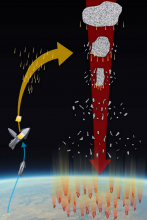Listen to today's episode of StarDate on the web the same day it airs in high-quality streaming audio without any extra ads or announcements. Choose a $8 one-month pass, or listen every day for a year for just $30.
You are here
Brilliant Venus
Venus, the “morning star,” is at its absolute best right now. The planet is in the east at first light. It’s so bright that you might think it’s an airplane or some other flying craft. That brightness is a combination of its distance from Earth, and the portion of its Earth-facing hemisphere that’s lit up by the Sun.
Venus is completely blanketed by bright clouds, which hide the surface. In fact, our only maps of the surface have come from radar — especially from a radar aboard the Magellan spacecraft, in the 1990s.
The clouds top an atmosphere that’s extremely thick and hot. It protects the surface from impacts by asteroids. All but the biggest ones burn up or explode before they can hit the ground.
But some of those explosions can be powerful enough to damage the surface. We’ve seen it happen on Earth several times since the early 20th century. Because Venus’s atmosphere is so much thicker than Earth’s, though, the damage can be more extensive.
A recent study found almost 300 “scars” from these airbursts. A pressure wave from the explosion slams into the surface, scouring out a shallow depression. The feature looks dark to the radar, with a brighter “halo” around it.
Scientists are studying those features in detail. That should help them better understand the history of Venus’s surface, which has been sculpted by huge volcanic eruptions — a violent past for the beautiful Morning Star.
Script by Damond Benningfield






